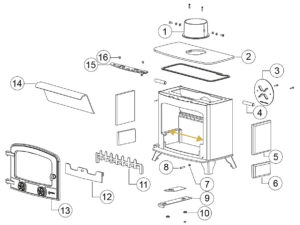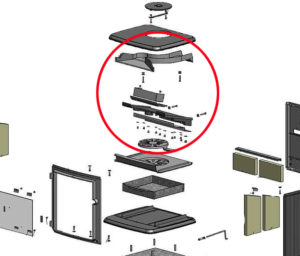What are the common parts in a Stove
In this help topic we are going to be looking at the common parts in a stove or woodburner. We’ll look at the different names used for components and where they are situated in an appliance. Of course, each manufacturer is different and there will always be variables. There will also be core differences between a multi fuel stove and a woodburner. What we aim to do here is simplify with diagrams and explain the jargon. We have a jargon busting stove Glossary here. First we’ll look at an older basic stove, then we’ll move on to a modern stove with all its technology.
Common Parts in Stoves.
Lets start with this older, basic Yeoman Devon wood burning stove. A very popular, traditional stove in the UK.

- 1. Flue Collar. Joins the appliance to the flue system. Generally fixed with screws or a twist lock arrangement.
- 3. Blanking Plate or sometimes referred to as a cover plate or hotplate. Blanks whichever flue exit is not in use.
- 4. See 14
- 5 & 6. Firebricks or Liners. Generally line the inside of the stove and protect the body of the appliance. they also reflect the heat back into the stove improving efficiency.
- 7, 8, 9, 10. these numbers are showing the primary air controls.
- 11 & 12. This is the front fuel retainers or log guards. They stop fuel from falling out the stove.
- 13. Main Fire Door. On the reverse will be a glass with a gasket seal and fixings. The door has a rope seal for ensuring the door is air tight. How to repair stove doors.
- 14. This is the baffle or throat plate, a common part in stoves. It stops flames going up into the flue, creates a natural draw and pushes heat to the front of the stove.
- 4. This item is exclusive the Yeoman range. Its an extension tube for the baffle to rest on. Unlikely to see this unless you have a Yeoman Stove.
- 15 & 16. Secondary Air Controls.
- Yellow Arrow. This diagram is of a woodburner. If it were a Multi Fuel you would have a grate arrangement along the lines of the arrow. An ashpan would be underneath for collecting ash and you may have a separate ash door on the outside.
Parts in a new stove
Now we move on to newer appliances with modern technology. Many of the basic principles are exactly the same as above. Therefore we wont need to go over them again. Where significant strides have been made in current stoves is the efficiency. This has come about through environmental awareness and has resulted in the ECO Design 2022 ruling. Modern (reputable) stoves are now far superior in efficiency which is great for both the planet and your pocket. You can find out if your stove is ECO Design compliant here.
So, how has this been achieved? One way is how the air is directed through the stove – in particular you may have heard of tertiary air. Tertiary air introduces additional oxygen into the firebox. This in turn re-ignites the gases above the flames enabling a more complete burn process. There are other improvements, such as improved control and better materials, but this is the one which you will be most aware of. Tertiary Air is a common part in stove of the modern era. How it is implemented will vary between manufacturer. The below diagram shows you how a Morso 3400 series incorporates this technology through its new baffle system.

If you’re thinking of upgrading your stove, check out our latest offering here.

